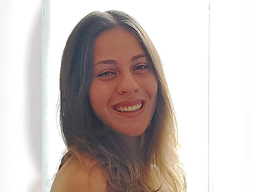Colloquium: Dr. Perla Alalam, Université de Lille
Online only
Location
Physics : 401
Date & Time
November 16, 2022, 3:30 pm – 4:30 pm
Description
TITLE: Aerosol Mineralogical Study using Laboratory Measurements and IASI Observations: Application to East Asian Deserts
ABSTRACT: East Asia is the second largest source of mineral-type aerosols in the world after the Sahara. These can modify the Earth's radiative balance due to their properties of absorption and diffusion of atmospheric radiation. Therefore, precise information on the physico-chemical properties of desert dust is essential to understand and better quantify their impact on the atmosphere. In this context, we aim to test the potential of a new methodological approach combining laboratory measurements and satellite remote sensing for better characterization of aerosols from the desert and semi-arid surfaces. The application concerns studying desert storm events in East Asia from the IASI spaceborn instrument.
One of the major difficulties of this work comes from the fact that mineral dust in East Asia is emitted above the continental surface in the lower troposphere, which poses constraints linked first to a low detection sensitivity due to a lack of thermal contrast and second due to the high influence and variability of the Land Surface Emissivity (LSE). Thus, the first part focused on improving the consideration of LSE by developing a new methodology from a set of average monthly emissivity dataset.
Then, experimental extinction coefficients of pure minerals were linearly combined to reproduce a spectrum of Gobi dust, which made it possible to obtain the mineralogical mass fractions. In addition, from the IASI radiances, an optical thickness of Gobi dust was calculated, displaying characteristics identical to those measured in the laboratory. The linear combination of pure mineral spectra was then applied to IASI optical thickness, providing mineralogical mass fractions. Finally, the entire methodology was applied to two dust events during two different seasons and years: May 2017 and March 2021. The method made it possible to obtain the first spatial and temporal distributions of the chemical composition of desert aerosols. The average mass fractions obtained for particles from the Gobi Desert, Taklamakan Desert, and Horqin Sandy Land are close to mass fractions from the literature. In addition, these results on the chemical composition made it possible to link aerosols' spatial variability to dust emission sources, confirmed using a backward trajectory model. In addition, comparing two IASI instruments on MetOp A and B showed good consistency, allowing us to consider the method's applicability to different MetOp platforms having the same instrument type. The results present an important advance in improving the characterization of desert aerosols by space remote sensing, in particular concerning the analysis of the chemical composition.
Meeting link:
https://umbc.webex.com/umbc/j.php?MTID=m6f9f638685d3c7e1a1145931c0cb1a30
Meeting number:
2621 616 7829
Meeting password:
a4aK6nx4PnF
Join from a video or application
Dial 26216167829@umbc.webex.com
You can also dial 173.243.2.68 and enter your meeting number.
Join by phone
+1-202-860-2110 United States Toll (Washington D.C.)
Access code: 26216167829
Global call-in numbers
https://umbc.webex.com/umbc/globalcallin.php?MTID=mbc7690421e049977b290b3ac86a03ba2
ABSTRACT: East Asia is the second largest source of mineral-type aerosols in the world after the Sahara. These can modify the Earth's radiative balance due to their properties of absorption and diffusion of atmospheric radiation. Therefore, precise information on the physico-chemical properties of desert dust is essential to understand and better quantify their impact on the atmosphere. In this context, we aim to test the potential of a new methodological approach combining laboratory measurements and satellite remote sensing for better characterization of aerosols from the desert and semi-arid surfaces. The application concerns studying desert storm events in East Asia from the IASI spaceborn instrument.
One of the major difficulties of this work comes from the fact that mineral dust in East Asia is emitted above the continental surface in the lower troposphere, which poses constraints linked first to a low detection sensitivity due to a lack of thermal contrast and second due to the high influence and variability of the Land Surface Emissivity (LSE). Thus, the first part focused on improving the consideration of LSE by developing a new methodology from a set of average monthly emissivity dataset.
Then, experimental extinction coefficients of pure minerals were linearly combined to reproduce a spectrum of Gobi dust, which made it possible to obtain the mineralogical mass fractions. In addition, from the IASI radiances, an optical thickness of Gobi dust was calculated, displaying characteristics identical to those measured in the laboratory. The linear combination of pure mineral spectra was then applied to IASI optical thickness, providing mineralogical mass fractions. Finally, the entire methodology was applied to two dust events during two different seasons and years: May 2017 and March 2021. The method made it possible to obtain the first spatial and temporal distributions of the chemical composition of desert aerosols. The average mass fractions obtained for particles from the Gobi Desert, Taklamakan Desert, and Horqin Sandy Land are close to mass fractions from the literature. In addition, these results on the chemical composition made it possible to link aerosols' spatial variability to dust emission sources, confirmed using a backward trajectory model. In addition, comparing two IASI instruments on MetOp A and B showed good consistency, allowing us to consider the method's applicability to different MetOp platforms having the same instrument type. The results present an important advance in improving the characterization of desert aerosols by space remote sensing, in particular concerning the analysis of the chemical composition.
Meeting link:
https://umbc.webex.com/umbc/j.php?MTID=m6f9f638685d3c7e1a1145931c0cb1a30
Meeting number:
2621 616 7829
Meeting password:
a4aK6nx4PnF
Join from a video or application
Dial 26216167829@umbc.webex.com
You can also dial 173.243.2.68 and enter your meeting number.
Join by phone
+1-202-860-2110 United States Toll (Washington D.C.)
Access code: 26216167829
Global call-in numbers
https://umbc.webex.com/umbc/globalcallin.php?MTID=mbc7690421e049977b290b3ac86a03ba2
